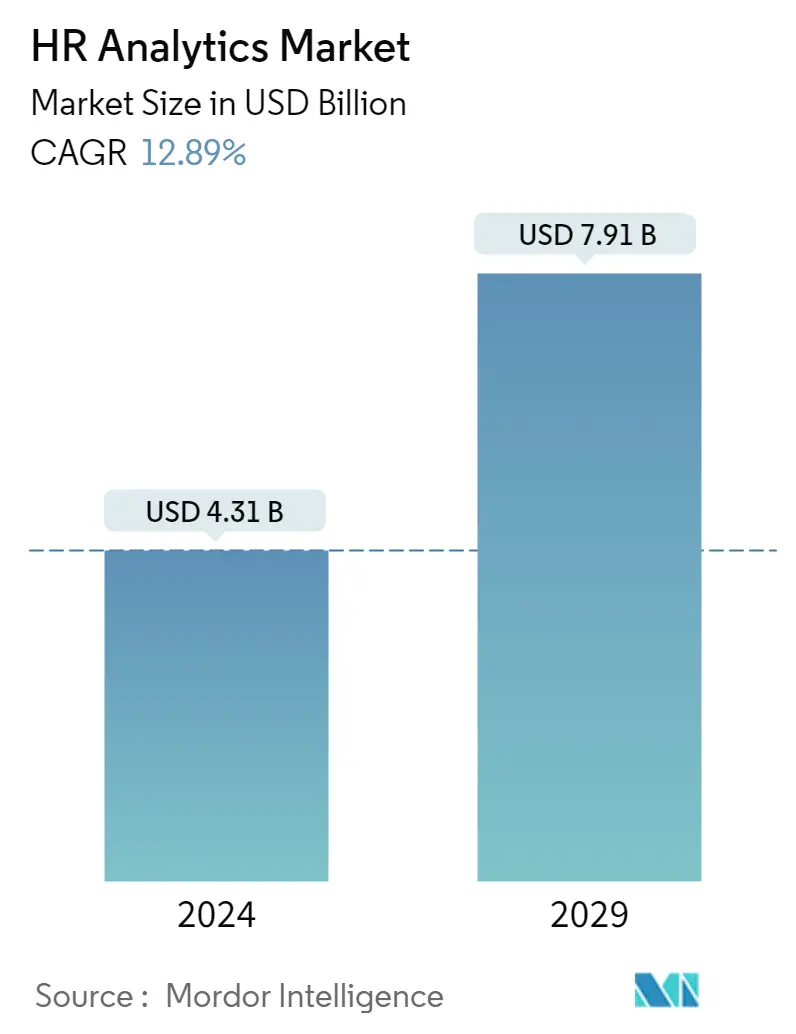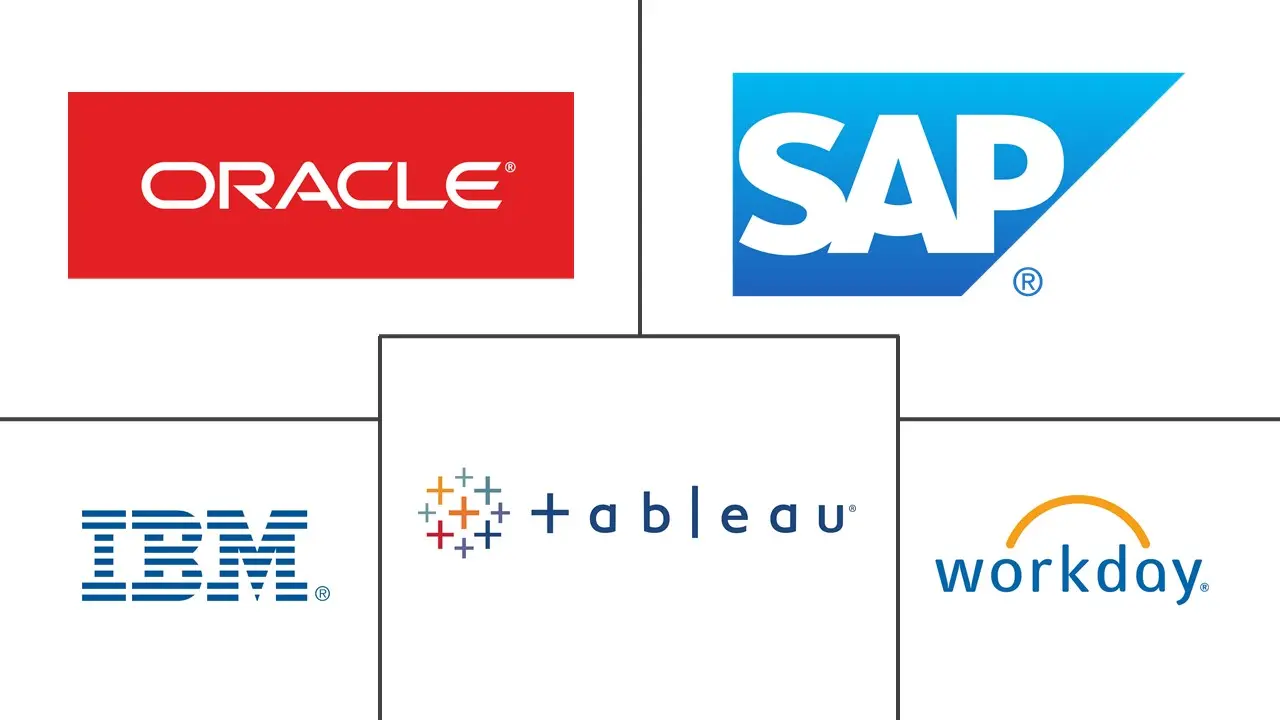Market Size of HR Analytics Industry

| Study Period | 2019 - 2029 |
| Market Size (2024) | USD 4.31 Billion |
| Market Size (2029) | USD 7.91 Billion |
| CAGR (2024 - 2029) | 12.89 % |
| Fastest Growing Market | Asia Pacific |
| Largest Market | North America |
Major Players
*Disclaimer: Major Players sorted in no particular order |
HR Analytics Market Analysis
The HR Analytics Market size is estimated at USD 4.31 billion in 2024, and is expected to reach USD 7.91 billion by 2029, growing at a CAGR of 12.89% during the forecast period (2024-2029).
By using data gathered, HR analytics aids in improving the productivity of HR services by making predictions about crucial factors, including performance, retention, and recruiting. These elements are all driving the market's expansion.
- By using HR analytics, HR departments can make data-backed decisions when it comes to managing attrition and spot areas where automation can be introduced. They can leverage the solution capabilities to capture insights on employee feedback forms. HR analytics can also implement artificial intelligence recruiters to automate interview scheduling, provide real-time feedback to employees, and improve the handling of Big Data HR analytics. This will not only help HR executives to save time but also money.
- One of the most important applications of HR analytics is the prediction of sick leaves or days off. For instance, the provider of financial protection benefits, Unum Group, launched a pilot project with the illness forecast application provider, Sickweather. The project identifies correlations between Sickweather's data from its real-time human health map and Unum's Family and Medical Leave Act (FMLA) and coded sick leave paid time off (PTO) data to forecast employee illness-related absence.
- Identifying the current and future skill gaps is another application for HR analytics. Mexico's Ministry of Energy uses a predictive workforce planning and analytics model to learn about the current shortage of skilled workers in the oil and gas industry and predict one over a 10-year horizon. The industry also started using workforce planning and analytics for renewable energy and sustainability in such sectors.
- One of the biggest challenges faced by organizations around the world is the management of people and talent. While continuing to work on improving hiring procedures, employee satisfaction, payroll issues, and retrenchment, an HR professional needs to keep everyone on the same page and still manage to get things done as expected by the company and managers. Due to the introduction of data analytics in HR processes, the approach has become simpler than ever, proving to be a major advantage for HR in their everyday work.
- The employee benefits trends survey by Metlife found that 72% of workers would desire limitless vacation time as a benefit. However, HR analytics can assist in making sure that employees are taking enough time off following the organization's regulations. HR analytics can also assist in monitoring each employee's overtime hours.
- The trend towards remote work has been gradually growing for the past few years. However, COVID-19 has dramatically accelerated this trend in an extremely short period of time, forcing companies, irrespective of their size, to adapt quickly to the self-isolation measures that governments across the globe were recommending. With the pandemic requiring much more people to work remotely, analytics solutions are becoming essential for companies as these solutions can help in managing the remote workforce efficiently and provide the ability to track the status of the workforce so that the company can report and analyze these trend and impact on the business.
HR Analytics Industry Segmentation
HR analytics refers to applying the analytic process to the human resource department's talent data to measure the performance and efficiency that matters to HR the most to drive better returns on investment. It deals with gathering data, and providing insights into each process to make relevant managerial decisions. The data may include the number of people trained, the number of people with certain competencies, and the number of candidates to have in the pipeline based on the estimated attrition among others to help managers to deliver compliance and diversity reports.
The HR Analytics Market is segmented by Component (Solutions and Services), Deployment Mode (On-Premise and Cloud), End-user Industry (BFSI, Telecom & IT, Consumer Goods & Retail, Healthcare, and Manufacturing), and Geography (North America (United States, and Canada), Europe (Germany, United Kingdom, France, and Rest of Europe), Asia-Pacific (India, China, Japan, and Rest of Asia-Pacific), Latin America (Brazil, Argentina, and Rest of Latin America), and Middle East and Africa (United Arab Emirates, Saudi Arabia, and Rest of the Middle East and Africa))
The market sizes and forecasts are provided in terms of value (USD million) for all the above segments.
| By Component | |
| Solutions | |
| Services |
| By Deployment Mode | |
| On-Premise | |
| Cloud |
| By End-User Industry | |
| Telecom and IT | |
| BFSI | |
| Consumer Goods and Retail | |
| Healthcare | |
| Manufacturing | |
| Other End-user Industries |
| By Geography | ||||||
| ||||||
| ||||||
| ||||||
| ||||||
|
HR Analytics Market Size Summary
The HR Analytics Software Market is poised for significant growth, driven by the increasing need for data-driven decision-making in human resource management. This market is expanding as organizations leverage analytics to enhance productivity, improve employee retention, and streamline recruitment processes. The integration of artificial intelligence and machine learning into HR analytics is transforming traditional HR functions, enabling departments to automate tasks such as interview scheduling and real-time employee feedback. This technological advancement not only saves time and resources but also aids in managing the complexities of remote workforces, a trend that has accelerated due to the COVID-19 pandemic. The ability to predict employee absenteeism and identify skill gaps further underscores the importance of HR analytics in strategic workforce planning.
North America leads the adoption of HR analytics, with significant uptake in sectors like banking and technology. The presence of major vendors such as IBM, SAP, and Oracle in this region has facilitated the widespread implementation of analytics solutions. These companies are enhancing their offerings through strategic acquisitions and collaborations, aiming to expand their market share and customer base. Despite the moderate fragmentation of the market, the focus on integrating advanced analytics into HR processes is evident across various industries, including IT and telecom. However, challenges such as limited awareness in the public sector and the impact of the pandemic on recruitment processes may hinder market growth. As organizations continue to recognize the value of data-driven insights, the HR analytics market is expected to experience robust expansion in the coming years.
HR Analytics Market Size - Table of Contents
-
1. MARKET INSIGHTS
-
1.1 Market Overview
-
1.2 Industry Attractiveness - Porter's Five Forces Analysis
-
1.2.1 Bargaining Power of Suppliers
-
1.2.2 Bargaining Power of Consumers
-
1.2.3 Threat of New Entrants
-
1.2.4 Threat of Competitive Rivalry
-
1.2.5 Intensity of Substitutes
-
-
1.3 Assessment of COVID-19 Impact on the Industry
-
-
2. MARKET SEGMENTATION
-
2.1 By Component
-
2.1.1 Solutions
-
2.1.2 Services
-
-
2.2 By Deployment Mode
-
2.2.1 On-Premise
-
2.2.2 Cloud
-
-
2.3 By End-User Industry
-
2.3.1 Telecom and IT
-
2.3.2 BFSI
-
2.3.3 Consumer Goods and Retail
-
2.3.4 Healthcare
-
2.3.5 Manufacturing
-
2.3.6 Other End-user Industries
-
-
2.4 By Geography
-
2.4.1 North America
-
2.4.1.1 United States
-
2.4.1.2 Canada
-
-
2.4.2 Europe
-
2.4.2.1 Germany
-
2.4.2.2 United Kingdom
-
2.4.2.3 France
-
2.4.2.4 Rest of Europe
-
-
2.4.3 Asia Pacific
-
2.4.3.1 India
-
2.4.3.2 China
-
2.4.3.3 Japan
-
2.4.3.4 Rest of Asia Pacific
-
-
2.4.4 Latin America
-
2.4.4.1 Brazil
-
2.4.4.2 Argentina
-
2.4.4.3 Rest of Latin America
-
-
2.4.5 Middle East and Africa
-
2.4.5.1 United Arab Emirates
-
2.4.5.2 Saudi Arabia
-
2.4.5.3 Rest of Middle East and Africa
-
-
-
HR Analytics Market Size FAQs
How big is the HR Analytics Market?
The HR Analytics Market size is expected to reach USD 4.31 billion in 2024 and grow at a CAGR of 12.89% to reach USD 7.91 billion by 2029.
What is the current HR Analytics Market size?
In 2024, the HR Analytics Market size is expected to reach USD 4.31 billion.

